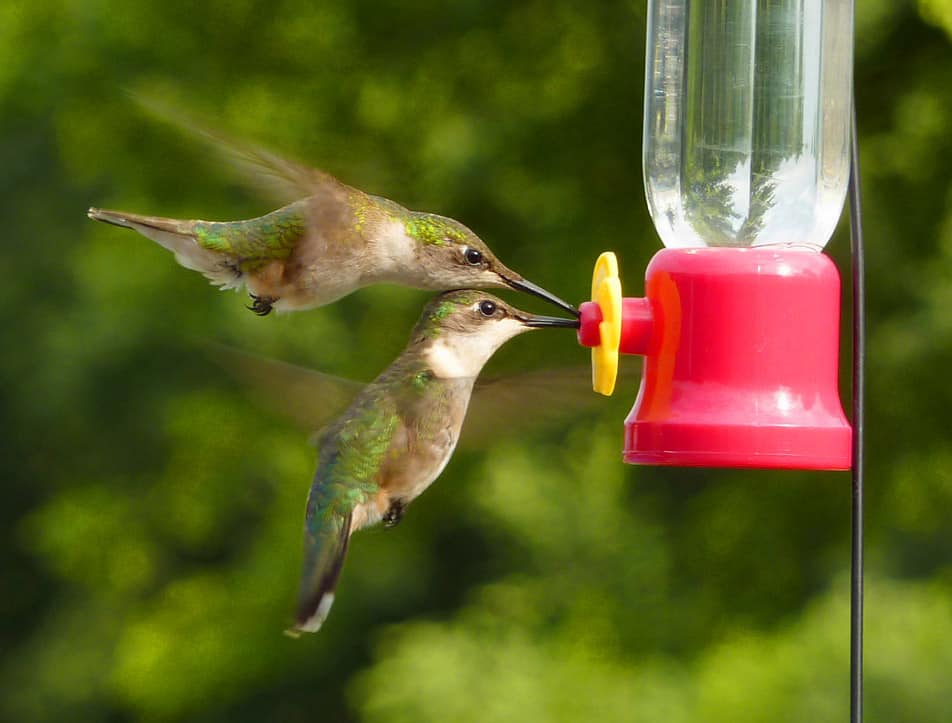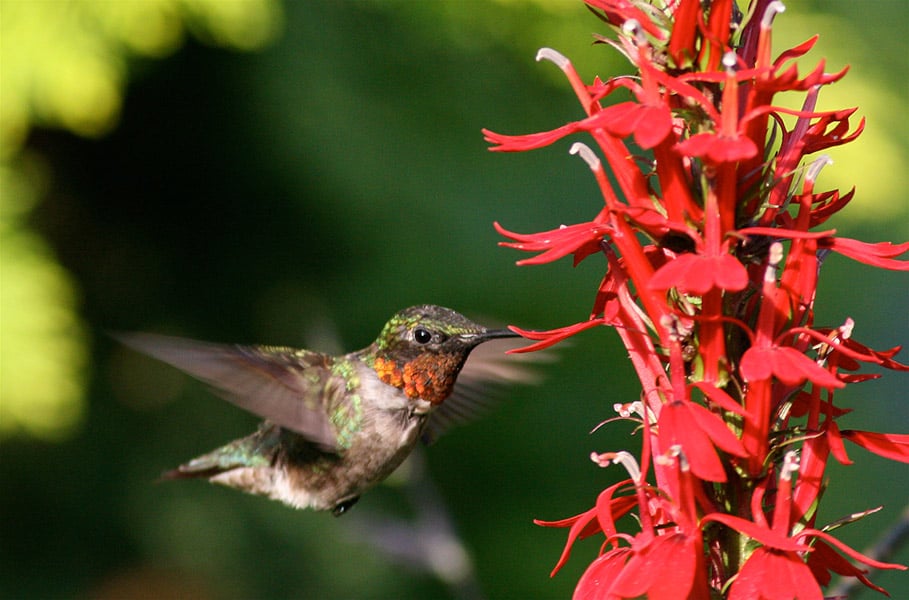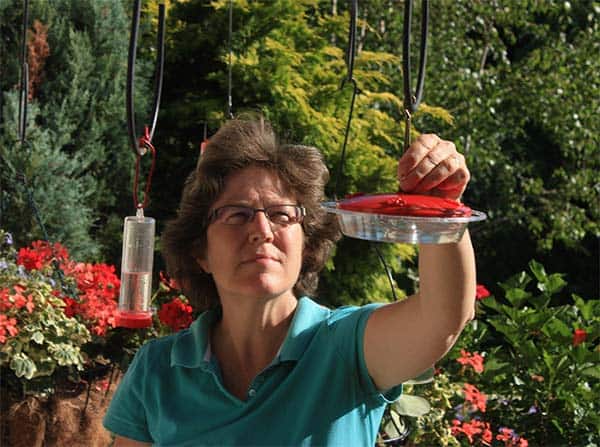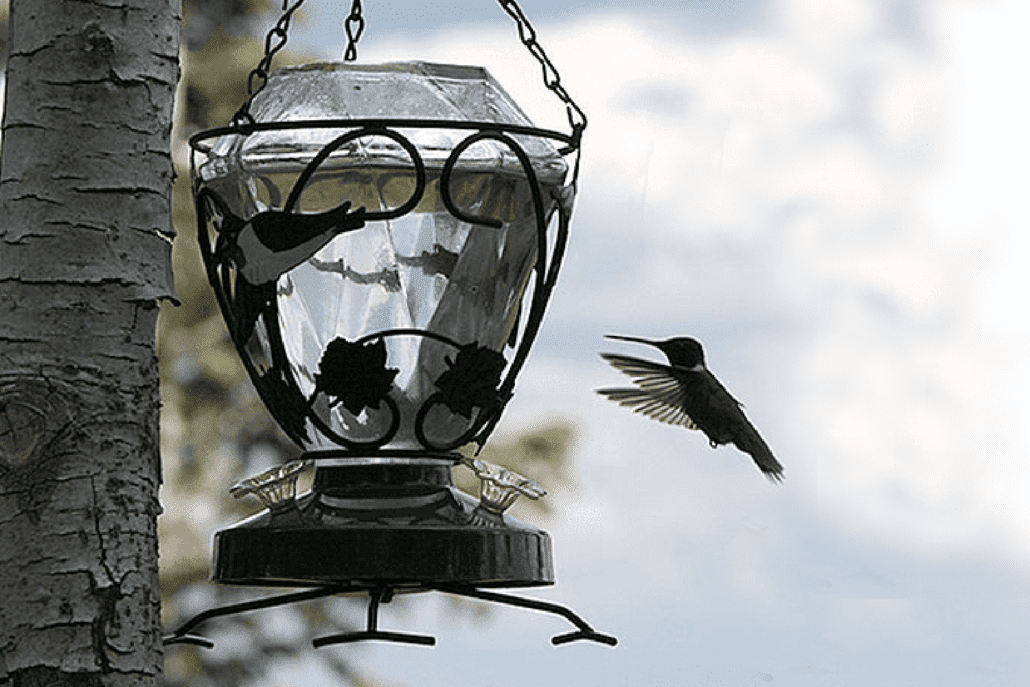For those of us who adore hummingbirds and enjoy watching their antics, late July and August are an exciting time of year, even though it means more effort to wash and refill the nectar feeders more often. Feeder visitors may include adults, and hatch-year birds, from the first brood, and in many areas, second-brood fledglings fresh from the nest.
Compare bill sizes of the hummingbirds at your feeder to determine whether those with pale throats are adult females or hatch-year birds, with still-growing bills. Watch, too, for hatch-year males, which may show a few red feathers on the throat. If you’re looking for easy ways to attract hummingbirds to your feeders, we have some suggestions!
1. Add more flowers/feeders.
Placing your feeders near flowers will increase the odds of hummingbirds finding them easily. Flowers first, feeders second. But you knew I was going to say that, didn’t you?
2. Try hanging baskets of flowers.
If planting flowers isn’t an option, buy hanging baskets of flowers. Any garden center worth a nickel will have flower-filled hanging baskets for sale. I rarely buy more than one, but that’s usually all it takes.
3. Add a water feature with a mister.
Hummingbirds love to bathe and mister gives them just the kind of fine spray of water they prefer. If you cannot find a commercial source selling a birdbath mister, poking some tiny holes in a length of old hose will work just fine. Place it near your birdbath so the mist is caught in the bath’s basin.
4. Place tiny perches around the yard.
We leave the bare dead branches in place at the crown of our ornamental Japanese maples because the hummers LOVE to perch on them. Think of how tiny hummingbird feet are, and find some small but sturdy branches to stick around your yard, garden, or deck. Once a hummer tunes in to a favorite perch, it will use it repeatedly.
5. Be prepared to clean your feeders frequently
In the higher temperatures of summer, sugar water spoils faster. Before you refill your feeder, give it a good cleaning. Only refill clean feeders!
6. Be organic
With their incredibly high metabolisms, hummingbirds are very susceptible to chemicals such as those used to control garden pests. If you want your hummingbirds to be healthy, avoid or limit the use of chemicals in your gardens and never use any chemicals of any kind on or near your hummingbird feeders.
7. Vary your habitat.
Hummingbirds need other kinds of habitat other than flowering plants. They need trees in which to nest, shrubs in which to shelter, places to forage for insects, and access to water for drinking and bathing. Making your yard more bird-friendly will automatically make it more hummingbird-friendly, too.
8. Add red ribbons and plastic flowers.
If you are just starting to establish your yard or garden for hummingbirds, and you want to catch the eye of a passing hummer, a quick way to do it is to hang something bright red or bright pink. The vision of hummingbirds seems to be particularly acute for colors in the pink–red–orange parts of the color spectrum, which is why so many native flowers that have evolved to be visited by hummingbirds are these colors. If you can’t get to the garden center for a hanging basket, hang out something red such as a piece of surveyor’s tape, an artificial flower, even a handkerchief.
9. Leave spider webs up.
Spider webs are one of the materials used by hummingbirds to weave together the nest. Look at a hummer nest closely and you’ll see the tiny fibers of spider webbing are what holds it together, what bonds it to its support, and what allows the nest to expand as the nestlings grow.
Avoid the temptation to sweep away spider webs in spring and summer when hummers might use them as building materials. Hummers also visit spider webs to swipe and eat insects caught in the webbing, yet another reason to leave those webs alone.
10. Rotten fruit!
This tip may be further than you’d like to go, but rotten fruit is very important to hummingbirds. Why? Rotten or rotting fruit attracts fruit flies and other insects, which are the perfect high-protein snacks for hummingbirds. Hummingbirds rely on insects as a major part of their diet.
Don’t believe me? Place a brown banana (or some other past-its-freshness-date fruit) out near your hummer feeder and leave it there until it begins to attract insects. Then watch to see if these insects don’t in turn attract hungry hummingbirds. I’ve seen this in action in our vegetable garden, where rotten tomatoes buzzing with insects had two female ruby-throats diving and snagging the flying bugs.




